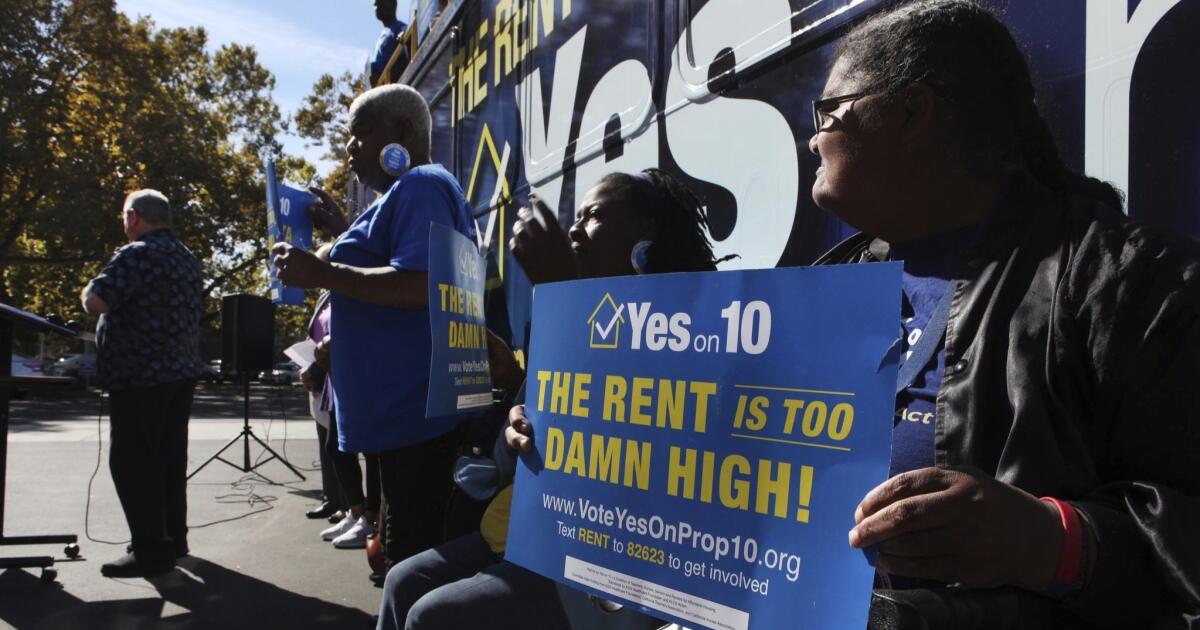California’s rent control initiative was crushed in the election. Don’t expect the issue to go away
Reporting from Sacramento — The defeat of a ballot measure that would have allowed for the expansion of rent control across California has buoyed landlords and left tenants pinning their hopes on the state’s new governor for relief.
Proposition 10 failed resoundingly with nearly 62% of voters rejecting the initiative as of results tallied Wednesday. The initiative would have repealed the Costa-Hawkins Rental Housing Act, which bans cities and counties from implementing more aggressive forms of rent control. The result means those prohibitions remain in place.
For the record:
3:20 p.m. Nov. 8, 2018An earlier version of this article stated that the Costa-Hawkins Rental Housing Act prohibits local governments from implementing rent controls on apartments built before 1995. The law prohibits rent controls on apartments built after 1995.
Landlord groups, which funded a nearly $80-million opposition campaign that outraised supporters 3 to 1, said voters made their opinions clear.
“When a measure loses by double digits, that’s such a strong message,” said Debra Carlton, senior vice president at the California Apartment Assn. “Certainly, any changes to rent control or Costa-Hawkins in general will be a heavy lift after this.”
Voters reject Proposition 10, halting effort to expand rent control across the state »
Supporters of expanding rent control, however, said the campaign pushed tenant concerns to the forefront of the state’s housing debate. They’re also taking solace in a pledge from Democratic Gov.-elect Gavin Newsom, who has said that he will try to strike a deal on new rent control policies upon taking office. Newsom opposed Proposition 10, saying that he preferred amending Costa-Hawkins rather than repealing it.
“What we’re seeing now is that families and seniors are being evicted, facing economic eviction right now,” said Jennifer Martinez, director of strategy for the nonprofit PICO California, a backer of Proposition 10. “That doesn’t seem to be slowing down. It seems to be growing to many more regions of the state. We need relief now.”
Martinez called the prospect of Newsom’s involvement “exciting and important.”
Voters from all parts of California opposed Proposition 10. The initiative was losing in all but one of the state’s 58 counties as of Wednesday, with only San Franciscans giving it majority support. Similarly, municipal efforts to implement some rent controls in Santa Cruz and National City, a small community south of San Diego, also appeared headed for defeat by large margins.
Tenant groups responded to Tuesday’s loss by protesting at the Santa Monica offices of Blackstone, the private equity firm that owns thousands of apartments in the state and was a major donor to the campaign against Proposition 10. At the rally, activists called on Newsom to address skyrocketing rents. Supporters also said they were open to tenant protections that were narrower than those proposed by the initiative.
Costa-Hawkins, which passed 23 years ago, prohibits local governments from implementing rent control on single-family homes, condominiums and apartments built after 1995 or earlier in Los Angeles, San Francisco and other cities with longstanding rent stabilization rules. It also gives landlords the right to charge rents at the market rate once a tenant in a rent-controlled unit moves out.
Proposition 10 would have repealed Costa-Hawkins entirely, leaving local governments to implement new rent stabilization rules at their discretion. In January, a legislative committee defeated a bill that also would have done away with Costa-Hawkins.
The failures show that lawmakers and advocates should take a different approach, said Assemblyman Rob Bonta (D-Alameda), a coauthor of the failed rent control bill.
“When you’ve tried something twice and it didn’t pass, you’ve gotta look at other alternatives, too,” Bonta said. “You can’t have blinders on.”
Bonta said he’s hoping his colleagues would consider legislation to counter rent gouging, limit conversions of rent-controlled apartments to for-sale condominiums and amend Costa-Hawkins rather than repealing it.
But the resounding defeat of Proposition 10 might add to the landlord lobby’s already strong position.
During debate over the legislation to repeal Costa-Hawkins, Carlton told lawmakers that her group was willing to consider changes that would allow cities and counties to place rent control rules on more recently built apartments. In an interview Wednesday, Carlton said Tuesday’s result made it less likely landlord groups would agree to such amendments.
“If I were to take the pulse at the moment I’d say they’d be less inclined,” she said. “That would be the logical conclusion.”
It’s unclear what Newsom plans to do. The governor-elect did not speak publicly to reporters on Wednesday, but previously told the Sacramento Bee that he expected to deal with rent control right away.
“I will take responsibility to address the issue if [Proposition 10] does get defeated,” Newsom said.
Adding tenant protections could be part of a larger package of new housing legislation and policies that Newsom is expected to propose in the coming year. He made addressing the state’s housing affordability problems a key campaign promise. Principally, Newsom has called for the construction of 3.5 million new homes by 2025, a level of production never seen in California — at least since the state building industry began keeping statistics in the 1950s.
Some supporters of Proposition 10 have been critical of Newsom’s positions on tenant issues. A top official at the AIDS Healthcare Foundation, a Los Angeles-based nonprofit that spent $23.2 million on the pro-Proposition 10 campaign described Newsom last week as “bought and paid for by the landlords and the Realtor lobby and the developer lobby.” But Michael Weinstein, the AIDS Healthcare Foundation’s president, said late Tuesday that he wanted to work with the new governor before deciding whether to put another rent control initiative on the 2020 ballot.
No matter what happens at the Capitol, there will be another major rent control debate in the state in the coming years. Residents in Sacramento, California’s sixth-largest city, have qualified an initiative for the 2020 ballot that would implement rent stabilization on older apartments. Michelle Pariset, an initiative proponent who works on statewide housing issues for the nonprofit law firm Public Advocates, said she hoped a local rent control battle in the shadow of the Capitol would spur legislators to act.
“When you try to do something progressive you lose a lot of the time,” Pariset said. “But you keep fighting.”











![PICTURED HERE IS Daniel Burton A young father-of-two was killed in a freak accident when he was crushed by his own car doing DIY repairs, an inquest heard. Mechanic Daniel Burton, 27, was repairing his own Audi A3 when the axle stand he was using slipped and left him crushed underneath. An inquest heard he […]](https://www.occasionaldigest.com/wp-content/uploads/2025/08/1755767728_989_Devoted-dad-of-two-27-crushed-to-death-by-car-in-freak.jpg)
